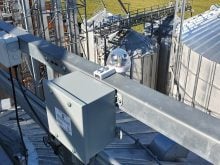Cloud seeding is a growing industry around the world, aimed at harvesting rain and snow.
In Canada, however, the emphasis has been more on softening the blow inflicted by hailstorms.
Cloud seeding is a way of modifying weather by attempting to draw more moisture out of rain clouds, or change the precipitation that falls. It is usually done by releasing silver iodide particles into clouds.
Jim Renick, a retired meteorologist and past manager of the Alberta Severe Weather Management Society, says attempts were made to create water in Saskatchewan in the 1930s but with limited success.
Read Also

Manitoba extends Crown land rent freeze
Manitoba government links the continued rental rate freeze on grazing and forage leases to economic and environmental challenges facing the industry
“I think it’s an issue of having enough of the right clouds and enough in the area where you want the precipitation. I believe it could be done and I think there would be some effect, but it might be pretty small.”
A common concern with cloud seeding is that it might rob other areas of rain.
“The answer is no,” Renick said.
“We’ve never seen any evidence to say that’s the case. When it rains in Alberta, does that mean it doesn’t rain in Saskatchewan? I look at it this way. If you seed a cloud, the moisture that falls on the ground evaporates tomorrow and is back in the atmosphere to produce another cloud.”
Terry Krauss, senior meteorologist at Weather Modification Inc., published a scientific article in the Journal of Atmospheric Research in 2004 that analyzed how hail suppression would affect precipitation in Alberta.
The study was motivated by concerns from rural residents during the drought of 2001-02 that hail suppression operations might reduce rainfall.
“The data support the claim that seeding caused an increase in rainfall,” he wrote.
“However, deliberate attempts to increase the precipitation over the larger agricultural area would necessitate a considerable increase in resources in order to seed a greater fraction of the total number of storms available.”
Alberta has focused on reducing hail damage because of the frequency of hailstorms in the Red Deer to Calgary region, nicknamed “Hail Alley.”
Renick said the area is rich in hailstorms because of the topography, with the mountains having the biggest influence.
Alberta Agriculture ran a cloud seeding program from 1973-85 based on evidence that shooting silver iodide into hail clouds could soften ice stones and keep them from growing to the size of baseballs.
Since 1996, an initiative spearheaded by the insurance industry has done similar work, but geared more toward reducing property rather than agricultural damage.
“In Alberta, the goal to seeding clouds is to reduce crop and property damage by reducing the size of hail,” Renick said.
The idea is to inject hail clouds as they form with tiny particles to encourage them to produce more and smaller stones. Silver iodide, which bursts into a cloud of smoke when fired from a flare mounted on the wing of an aircraft, has been used since the 1950s to make artificial ice nuclei. Renick said a few grams form billions of particles.
Clouds are seeded as they form to break up the process before it has a chance to create large hailstones.
“Insurance companies are backing the project because they’ve seen the results on the bottom line.”
Renick said most of the seeding is done by airplane when storms are expected to be intense enough to produce hail.
Firing silver iodide flares from the wings of aircraft is considered the most efficient delivery system, he added.
“It can be fairly exciting. It saves me a trip to the fair’s roller coaster ride,” he said.
“It does require flying in the updraft area of the storm and that’s where it gets exciting. You get a bit of a boost. We’ve been doing it for a number of years without any particular incidents, but it’s an interesting ride for sure.”
Pilots have to keep seeding storms as long as they persist because it will continue to draw in fresh air and moisture.
“You just can’t seed it and let it go. As long as you keep getting new growth and new air going into the storm it has to be continually seeded until it dies or moves past the area you’re trying to protect.”
Seeding the clouds
- Modern cloud seeding has been used in nearly 50 countries in the last 50 years.
- As the need for water increases worldwide, the demand for weather modification services will also increase. Similar increase in demand will occur in hail-prone regions.
- More countries are turning to cloud seeding to battle drought and maintain demand for water used in industry.
- China is a recognized leader with more than 40 years in weather control. With a population of 1.3 billion people, it requires vast amounts of water. The government practices cloud seeding to try to produce rain for farmers, stave off drought, clear away air pollution and smog and fill reservoirs. It was reported that during the lead up to the 2008 Summer Olympics, which fell during a traditional wet season for Beijing, any clouds that appeared were shot down.















